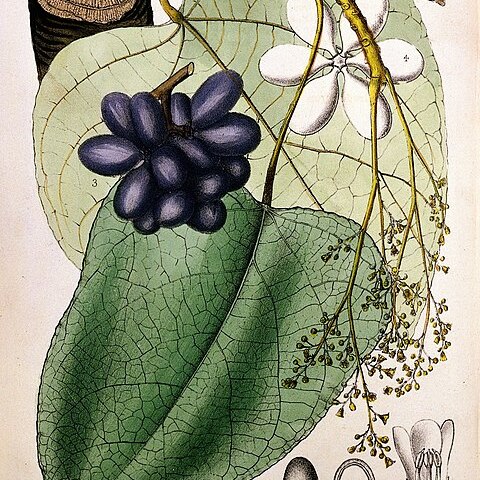Shrubby twiners; stems striate with the bark of older stems verrucose-lenti-cellate, minutely puberulent to tomentose, rarely glabrous. Leaves petiolate, ovate, deltoid or suborbicular, entire to crenate, the apex obtuse or acute, mucronate or sometimes emarginate, the base cordate, subcordate or truncate, 10-18 cm. long, 9-18 cm. wide, at length subcoriaceous, 5-, 7-or 9-pli-nerved, glabrous above, white and woolly beneath; petioles distally and proximally swollen, 4-14 cm. long, puberulent to tomentose. Staminate inflorescence fasciculate in the leaf axils, paniculiform, 6 cm. or more in length, the rachis tomentose; bracts and bracteoles ovate, about 0.5 mm. long. Staminate flowers (in Panama): Sepals 9, 14, or 16, irregularly imbricate, the 3, 8, or 10 exterior small, broadly ovate, rounded or obtuse at the apex, 0.5-1.4 mm. long, 0.5-1.2 mm. wide, exteriorly tomentose or with the margins ciliolate, the 6 interior conspicuously larger, oblong-ovate, 2.5-3.0 mm. long, 1.5-1.7 mm. wide, glabrous or with the margins ciliolate; petals 6, minute, broadly ovate or lanceolate, acute or acuminate at the apex, 0.5-0.8 mm. long, 0.3-0.5 mm. wide, glabrous; stamens 6, 1.5 mm. long, inflexed, the connective produced beyond the thecae, the filaments free or coherent at the base. Pistillate flower or fruit not seen.
More
A large creeper. It can grow 30 m high and spread widely. The trunk is hairy. It can be 10 cm across. The leaves are oval or rounded. They can be heart shaped. They are alternate. They are 20 cm long. The leaves underneath and the leaf stalks are woolly. The flowers are separately male and female on separate plants. They are small and green-white. The fruit are fleshy and oval. They are 1-2 mm long.

